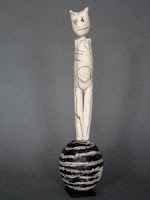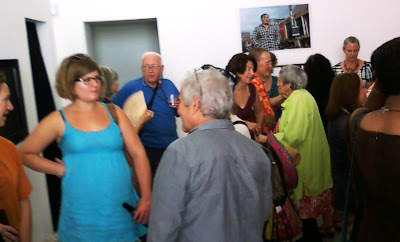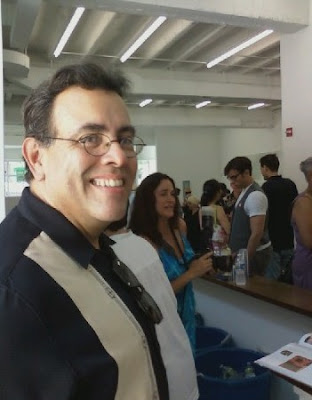>
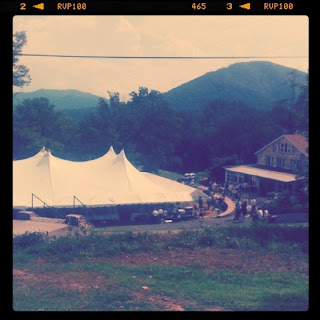
View of Penland Auction tent. Photo by Sean Hennessey.
Penland School of Crafts held its 26th Annual Benefit Auction this past week. The gala weekend in the North Carolina mountains featuring the sale of more than 230 works in books, clay, drawing, glass, iron, letterpress, metals, painting, photography, printmaking, textiles, and wood. The auction is one of the most important craft collecting events in the Southeast and helps support Penland’s educational programs, which have helped thousands of people to live creative lives.

Under the tent, the auctions are preceded with cocktails and dinner.
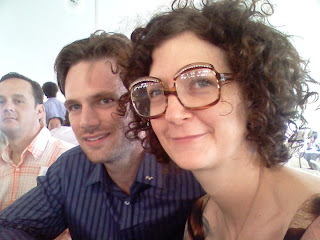
Evan Morgan and jeweler/artist Lola Brooks.

Noted wood art collector Fleur Bresler and her son Ed Bresler.
Glass artist Susan Taylor Glasgow.

Wyona Lynch-McWhite, Executive Director of the Fuller Craft Museum and glass/concrete artist Sean Hennessey.

Collectors had a chance to look thru the Penland catalog at amazing works.
This summer’s Penland Auction made a record amount of over $600,000 raised with over 550 people attending, not to mention a hundred local volunteers!
One of the highest bid pieces was Tim Tate’s “Four Seasons”….a cast glass and video series sculpture, tying the record amount for a non-commissioned with, set by Penland’s favorite potter, Cynthia Bringle.
Tim Tate’s “Four Seasons”

Showcasing the artwork during the auction.
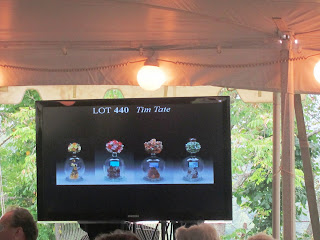
Tim’s work on the auction screen.
Want to see a vid of the actual record-tying auction? Click on image below to watch the auction of Tim’s artwork.
New Class Added to Schedule – Basic Arduino!
>
Class 1125- Using New Technology in Your Artwork – Basic Arduino For Artists

For more info on classes and to pay online- click HERE.
CMOG "New Glass Review 33": A Call for Entries
>
Corning Museum of Glass has posted its annual Call for Entries in the museum’s New Glass Review publication. All glassmakers, artists, designers, and companies are invited to participate in New Glass Review 33. Only glass designed and made between October 1, 2010, and October 1, 2011, may be submitted for this annual survey.
All glassmakers, artists, designers, and companies are invited to participate in New Glass Review 33. Only glass designed and made between October 1, 2010, and October 1, 2011, may be submitted for this annual survey.
From CMOG’s website:
Each year, The Corning Museum of Glass conducts a worldwide competition to select 100 images of new works in glass. A committee drawn from designers, artists, curators, and critics makes the selection. The publication is intended to keep its audience, which includes museums, artists, libraries, collectors, scholars, and dealers, informed of recent developments in the field. Objects considered excellent from any of several viewpoints—such as function, subject matter, aesthetics, and technique—will be chosen. The objects selected will be published in color with the names of the makers and brief descriptions of the pieces.
Participants are requested to complete the entry form, submitting a total of three digital images illustrating one work per image. Slides and transparencies will not be accepted. Three images of different pieces are preferred, although participants may send multiple views of one or two pieces. Digital photographs, which should be made using the highest-resolution setting on the camera, must be of actual objects designed and made between October 1, 2010, and October 1, 2011.
The New Glass Review competition will be judged in early December. All entries, accompanied by a $20.00 USD entry fee, must be postmarked no later than October 1, 2010, and sent to: New Glass Review Curatorial Department The Corning Museum of Glass, One Museum Way Corning, New York 14830-2253, USA.
For more info – click HERE.
For a look at some of the winners of New Glass Review 31 – click HERE.
The Process: Setting Up a Museum Solo Exhibition
>
As part of an ongoing series, we focus on the process of an event or artwork as the basis for the blog posting. Today, the blog posting is a two-fer where the photo documentation is both about Michael Janis’ creative process and info about Michael Janis’ solo show at Fuller Craft Museum, opening this Saturday, August 6, 2011.
The Fuller Craft Museum, Brockton, Massachusetts
The lead time for a museum show is very long – the Fuller Craft Museum contacted Michael in 2009 requesting a solo show at the museum in 2011, so Michael has been planning some aspect of the work for well over a year and features twenty five of his glass artworks. This posting will focus on his site specific sculpture in the show – titled “Unpredictable Factors”.
To help visualize the space, images of previous exhibitions and a floor plan of the gallery space within the museum were sent to Michael to help plan out the show.
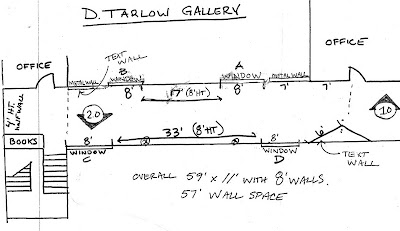
Floor Plan of Fuller Museum’s Tarlow Gallery
Marc Petrovic’s exhibition in Fuller’s Tarlow Gallery 2007.
Michael said that he wanted to create a large scale work for the museum show, and had focused on using one of the 8′ wide floor-to-ceiling window areas as the location, with the idea that the light and view beyond could be integrated into the work.
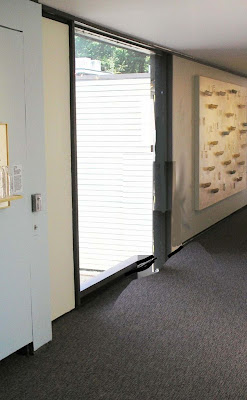

Sketches were integrated with photos of the gallery as the studies advanced.
Michael focused on the design with a central image sculpture and proceeded forward with creation of the other artwork pieces for the show. Working with noted metalsmith Chris Shea, the architectural metal work for the large sculpture was created.
Firing of separate layers of the components within the sculpture and the fitting to the metal framework took place in late spring of 2011.
In August, all 25 works by Michael Janis were crated and packed for shipping to the Fuller Craft Museum in Brockton – about 20 miles south of Boston, Massachusetts.
Fuller Registrar Donna Eleyi inspects the incoming work.
The condition of each piece is noted and the packing is documented. Here Donna Eleyi photographs the unpacking by Preparator Jason Ram.
The works are placed to allow for the arrangement by Fuller Museum curator Perry Price.

Installation of the steel framework for Michael Janis’ large sculpture “Unpredictable Factors” proceeds.
The exhibition opens Saturday, August 6, and there is a public reception August 7, from 2-5 pm. For more info on Michael’s lecture at the museum- click HERE.
Reception Aug 7, 2011, 2-5pm
455 Oak Street
Brockton, MA 02301

Artists & Websites
>There is no denying that getting your creative work noticed online is HARD. Art galleries as they now exist, are the old fashioned way of selling art. The competition is vast and ever growing. Every day more and more artists add their artwork to the enormous selection of artwork already available online. How can one even begin to make a dent in that mountain of content and be noticed? Every artist needs their own website, and every artist needs to get their own website now. Every artist needs to become conscious of the new way people are viewing and experiencing art. There are literally billions of people out there who don’t know that you or your art exists. They associate your subject or medium with artists who show up on search engines. They don’t care about what gallery you may be associated with, they care about who shows up on the Web. If you don’t start showing up on the Web very soon, not only will no one know who you are, they won’t even care.
Susan Lomuto – the writer of Daily Art Muse – research diva, an ex-non-profit executive  director, a lover of contemporary fine craft has been working with artists and their careers for some time now. Susan had worked an internship here in the DC area’s Gateway Arts District this year to focus on defining how artists work and interact with each other and the community. Susan had just put out a new book and course that deals with artists and defining themselves online.
director, a lover of contemporary fine craft has been working with artists and their careers for some time now. Susan had worked an internship here in the DC area’s Gateway Arts District this year to focus on defining how artists work and interact with each other and the community. Susan had just put out a new book and course that deals with artists and defining themselves online.
In Artist Online – a 12-week program, Susan walks you through the confusing maze of choices, answer your questions and teach you the basics using a combination of conference calls, screencast tutorials, handouts, forum posts, email and live online instruction.
Click HERE to read more about the course.
Susan’s also has a new book – The Cool, Calm & Collected Guide To A Better Artist Website: Tools and tips to help you create a website without raising your blood pressure or breaking the bank
Inside the book you will find:
- Susan’s number one tip to make your website rock.
- 8 steps to help you activate the tip.
- More than 30 resources to help you create and maintain a professional website for your art and increase the efficiency of your business workflow.
- Filled with beautiful images and quotes to inspire you on the journey, this guide will help you create a website while staying cool, calm and collected.
Click HERE to jump to info on the book.
Still More Glass Fun Facts: Is Glass Solid or Liquid?
>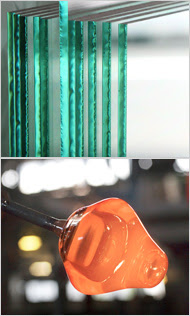
We have often been told that old European cathedrals glazing show glass is still moving in a semi-solid state as the stained glass panels thicker at the bottom – right? Yes and no – but not for the change in the thickness of the glass.
Way back in 2008, this NY Times Science article delved into the nature of glass –
“…The (cathedral stained glass) tale contains a grain of truth about glass resembling a liquid, however. The arrangement of atoms and molecules in glass is indistinguishable from that of a liquid. But how can a liquid be as strikingly hard as glass?
“They’re the thickest and gooiest of liquids and the most disordered and structureless of rigid solids,” said Peter Harrowell, a professor of chemistry at the University of Sydney in Australia, speaking of glasses, which can be formed from different raw materials. “They sit right at this really profound sort of puzzle.”
“…scientists still disagree, with some vehemence, about the nature of glass.”
“Scientists are slowly accumulating more clues. A few years ago, experiments and computer simulations revealed something unexpected: as molten glass cools, the molecules do not slow down uniformly. Some areas jam rigid first while in other regions the molecules continue to skitter around in a liquid-like fashion. More strangely, the fast-moving regions look no different from the slow-moving ones.
Meanwhile, computer simulations have become sophisticated and large enough to provide additional insights, and yet more theories have been proffered to explain glasses.”
“The glass transition does not occur at a single, well-defined temperature; the slower the cooling, the lower the transition temperature. Even the definition of glass is arbitrary — basically a rate of flow so slow that it is too boring and time-consuming to watch. The final structure of the glass also depends on how slowly it has been cooled.”
The (very tech) article includes discussions what would happen with “cooling at an infinitely slow rate” – so not going to happen in this busy studio.
Click HERE to jump to the 2008 Kenneth Chang article in the NY Times.
Previous Glass Fun Facts postings:
Glass Fun Facts: Gaffer/Composer
More Glass Fun Facts: Bullseye Glass
Float Glass Fun Facts
Glass Fun Facts – Shattered Glass Predicts Weather
Michael Janis’ Solo Exhibition @ Fuller Craft Museum
>
Fuller Craft Museum, Brockton, Massachusetts
Founded as a traditional fine arts museum and cultural center, over the past four decades the Fuller Craft Museum has transformed itself into a collection devoted entirely to crafts, one of only eight such museums in the US.
New England’s only museum of contemporary craft presents A Lighter Hand: The Glass Drawings of Michael Janis, on display Aug. 6 – Nov. 6, 2011.
One of the new works Michael has made for the exhibition is a site-specific sculpture that measures 8′-0″ and will be installed in floor to ceiling window of the exhibition space.

Michael Janis Unpredictable Factors
3′-0″W x 8′-0″H x 4″ fused glass, glass powder imagery, steel
Michael Janis Unpredictable Factors (detail)
3′-0″W x 8′-0″H x 4″ fused glass, glass powder imagery, steel
From the Fuller Craft Museum press release:
Building on the legacy of Surrealist artists of the early 20th century, in particular Giorgio de Chirico whose paintings juxtaposed disparate objects in moody and indistinct landscapes, Janis is able to construct a contemplative feeling from the layering of seemingly inanimate objects and ambiguous characters. His images in glass, particularly those examples in a tall and narrow format, also allude to the narrative quality of stained glass.
The juxtaposition of text, symbols, and figures seem to imply a hidden message or meaning, but like an ink blot or word association Janis leaves the viewer to provide their own conclusions.
Janis lives and works in Washington, DC, where he is Co-Director and an instructor at the Washington Glass School. He first began working with glass as an architect, evident in his dedication to sheet glass and the precision draftsmanship in his drawings. Fuller Craft will celebrate the opening of A Lighter Hand, with a public reception August 7 at 2 p.m. at the Museum. The reception is free for members and free with museum admission for all others.”
A lecture by Michael Janis precedes the public reception – click HERE for more information.

The Fuller Museum is located at 455 Oak Street, Brockton, MA 02301
Visiting Artists – Melissa Stern
>
NY- based artist Melissa Stern has been working recently in the glass school. Best know for her mixed media sculptures and drawings, Melissa has expanded her repertoire to include glass.
Melissa’s artwork is deceptive in its playful, childlike quality. Her highly imaginative (and frequently amusing) ceramic sculptures and drawings usually featuring human figures which call to mind sophisticated illustrations for children’s stories. Melissa sees her work removed from specific narrative and functioning instead in terms of psychology and metaphor. As much as we would like a ceramic standing figure–feet nailed to the floor, arms holding aloft a branch upon which large birds perch–to introduce a fascinating if disturbing fable, there is no story to explain it.
Summer in the South, collage, oil paint, pencil, 12 x 9
World View , clay, acrylic, paper, graphite, encaustic, 23″ x 5″ x 5″
Translating her drawn imagery with the use of glass frit powder, Melissa has really taken to the process, making it her own.
Melissa Stern’s fused glass frit components are assembled onto the glass panels she is creating.
Melissa and Tim Tate discuss the development of her panels.
Carving holes, tack-fusing texture, layering images – Melissa will ultimately add other non-glass elements to the glass panels she is creating.
We look forward to seeing the finished works by Melissa! And congratulations, Melissa, on becoming an adjunct professor at Brooklyn College!
Book Release Party for "100 Artists of Washington, DC"
>
This weekend, the book release party was held at the beautiful Conner Contemporary Art Gallery in Washington, DC. As the Mid-Atlantic sweltered in record-breaking high temperatures, the cool crowd was in force at the book reception. The book is incredible – the production quality is very high and the selection of the artists represented and the artwork included all contribute to a fantastic compendium of the best of the DC area art scene. Though I understand the first set of books from the publisher is already sold out at places like Amazon Books, more books are due soon.
Artist/Author F Lennox Campello at his book release, held at Conner Contemporary.
The crowds braved the heat to get their first look at the book.
Tim Tate waves a jaunty ‘hello’ to this intrepid reporter.
26th Annual Penland Auction
>The 26th Penland School of Crafts Benefit Auction takes place August 12-13, 2011. This gala weekend in the North Carolina mountains featuring the sale of more than 200 works in books, clay, drawing, glass, iron, letterpress, metals, painting, photography, printmaking, textiles, and wood. The Penland auction is one of the most important craft collecting events in the Southeast and a perfect opportunity to support Penland’s educational programs, which have helped thousands of people to live creative lives. Work by WGS Director Tim Tate is featured in the auction – and one of the works is previewed below.
Focus on Materials: Glass in This Year’s Auction
Tim Tate Four Seasons
Blown and cast glass, electronic components, original video
18 x 36 x 8 in.
For some years, Tim Tate has been developing a unique sculptural form that combines intricate glass castings and continuous video loops (displayed on tiny monitors) enclosed in glass bell jars to create what he calls “electronic reliquaries.” Through these pieces Tim has explored social issues, autobiography, cultural artifacts, and his observations of life. In this suite, he has created gentle evocations of each of the four seasons. “The piece works as a crossover between 20th and 21st century aesthetics,” he says. “The lost-wax casting is very intricate and complex, using hundreds of individually cast components. This is contrasted by the very direct and compelling video selections.”
Click HERE to jump to the full Auction Catalog.
For More info: call 828-765-2359, ext. 40 or email: auction@penland.org











